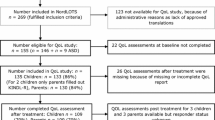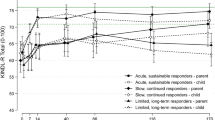Abstract
Although the “presence of obsessive–compulsive (OC) symptoms” and “OC-related impairment” are the main criteria to diagnose obsessive–compulsive disorder, the significance of symptomatology versus impairment in explaining quality of life remains unclear. The present study relies on two samples including 462 children (8–11 years old) and 265 children and adolescents (10–17 years old) and explores how self-ratings of specific OC symptoms and OC impairment are associated with father ratings of childhood quality of life. Hierarchical regression analysis was used to investigate the additive effect of OC impairment beyond OC symptomatology (and vice versa) in predicting quality of life. The results demonstrated that specific OC symptoms and OC impairment are differentially related to quality of life, underscoring the additive value of OC impairment beyond OC symptomatology, whereas the reverse was not the case. This finding highlights the importance of measuring impairment besides symptomatology to identify those OC features in childhood that are most significantly related to decreased quality of life.
Similar content being viewed by others
Notes
We did not include age or gender as covariates due to their negligible effects.
References
American Psychiatric Association (2013) Diagnostic and statistical manual of mental disorders, 5th edn. Arlington, VA
Merlo LJ, Storch EA, Murphy TK, Goodman WK, Geffken GR (2005) Assessment of pediatric obsessive–compulsive disorder: a critical review of current methodology. Child Psychiatry Hum Dev 36(2):195–214. doi:10.1007/s10578-005-4079-7
Abramowitz JS, Deacon BJ, Olatunji BO, Wheaton MG, Berman NC, Losardo D et al (2010) Assessment of obsessive–compulsive symptom dimensions: development and evaluation of the dimensional obsessive–compulsive scale. Psychol Assess 22(1):180–198. doi:10.1037/A0018260
Butwicka A, Gmitrowicz A (2010) Symptom clusters in obsessive–compulsive disorder (OCD): influence of age and age of onset. Eur Child Adolesc Psychiatry 19(4):365–370. doi:10.1007/s00787-009-0055-2
Foa EB, Coles M, Huppert JD, Pasupuleti RV, Franklin ME, March J (2010) Development and validation of a child version of the obsessive compulsive inventory. Behav Ther 41(1):121–132
Mervielde I, De Clercq B, De Fruyt F, Van Leeuwen K (2005) Temperament, personality, and developmental psychopathology as childhood antecedents of personality disorders. J Pers Disord 19(2):171–201. doi:10.1521/pedi.19.2.171.62627
De Caluwé E, De Clercq B (2014) Development and validation of the youth obsessive–compulsive symptoms scale (YOCSS). Child Psychiatry Hum Dev 45:647–656. doi:10.1007/s10578-013-0433-3
Eisen JL, Mancebo MA, Pinto A, Coles ME, Pagano ME, Stout R, Rasmussen SA (2006) Impact of obsessive–compulsive disorder on quality of life. Compr Psychiatry 47(4):272–277. doi:10.1016/j.comppsych.2005.11.006
Storch EA, Lack CW, Simons LE, Goodman WK, Murphy TK, Geffken GR (2007) A measure of functional impairment in youth with Tourette’s syndrome. J Pediatr Psychol 32(8):950–959. doi:10.1093/jpepsy/jsm034
Jacoby RJ, Leonard RC, Riemann BC, Abramowitz JS (2014) Predictors of quality of life and functional impairment in obsessive–compulsive disorder. Compr Psychiatry 55(5):1195–1202. doi:10.1016/j.comppsych.2014.03.011
McGuire JF, Arnold E, Park JM, Nadeau JM, Lewin AB, Murphy TK, Storch EA (2014) Living with tics: reduced impairment and improved quality of life for youth with chronic tic disorders. Psychiatry Res. doi:10.1016/j.psychres.2014.11.045
Sylvia LG, Rabideau DJ, Nierenberg AA, Bowden CL, Friedman ES, Iosifescu DV et al (2014) The effect of personalized guideline-concordant treatment on quality of life and functional impairment in bipolar disorder. J Affect Disord 169:144–148. doi:10.1016/j.jad.2014.08.019
Rajmil L, Herdman M, Ravens-Sieberer U, Erhart M, Alonso J, Grp EK (2014) Socioeconomic inequalities in mental health and health-related quality of life (HRQOL) in children and adolescents from 11 European countries. Int J Public Health 59(1):95–105. doi:10.1007/s00038-013-0479-9
Bastiaansen D, Koot HM, Ferdinand RF (2005) Determinants of quality of life in children with psychiatric disorders. Qual Life Res 14:1599–1612. doi:10.1007/s11136-004-7711-2
Schou I, Ekeberg O, Ruland CM (2005) The mediating role of appraisal and coping in the relationship between optimism-pessimism and quality of life. Psychooncology 14(9):718–727. doi:10.1002/896
Conelea CA, Woods DW, Zinner SH, Budman CL, Murphy TK, Scahill LD et al (2013) The impact of Tourette syndrome in adults: results from the Tourette syndrome impact survey. Community Ment Health J 49(1):110–120. doi:10.1007/s10597-011-9465-y
Rapaport MH, Clary C, Fayyad R, Endicott J (2005) Quality-of-life impairment in depressive and anxiety disorders. Am J Psychiatry 162(6):1171–1178. doi:10.1176/appi.ajp.162.6.1171
Olatunji BO, Cisler JM, Tolin DF (2007) Quality of life in the anxiety disorders: a meta-analytic review. Clin Psychol Rev 27(5):572–581. doi:10.1016/j.cpr.2007.01.015
IsHak WW, Greenberg JM, Balayan K, Kapitanski N, Jeffrey J, Fathy H et al (2011) Quality of life: the ultimate outcome measure of interventions in major depressive disorder. Harv Rev Psychiatry 19(5):229–239. doi:10.3109/10673229.2011.614099
Macy AS, Theo JN, Kaufmann SCV, Ghazzaoui RB, Pawlowski PA, Fakhry HI et al (2013) Quality of life in obsessive compulsive disorder. CNS Spectr 18(1):21–33. doi:10.1017/S1092852912000697
IsHak WW, Greenberg JM, Saah T, Mobaraki S, Fakhry H, Wu Q et al (2013) Development and validation of the individual burden of illness index for major depressive disorder (IBI-D). Adm Policy Ment Health 40(2):76–86. doi:10.1007/s10488-011-0376-6
Lack CW, Storch EA, Keeley ML, Geffken GR, Ricketts ED, Murphy TK, Goodman WK (2009) Quality of life in children and adolescents with obsessive–compulsive disorder: base rates, parent-child agreement, and clinical correlates. Soc Psychiatry Psychiatr Epidemiol 44(11):935–942. doi:10.1007/s00127-009-0013-9
Stewart SE, Geller DA, Jenike M, Pauls D, Shaw D, Mullin B, Faraone SV (2004) Long-term outcome of pediatric obsessive–compulsive disorder: a meta-analysis and qualitative review of the literature. Acta Psychiatr Scand 110(1):4–13. doi:10.1111/j.1600-0447.2004.00302.x
Nadeau JM, Lewin AB, Arnold EB, Crawford EA, Murphy TK, Storch EA (2013) Clinical correlates of functional impairment in children and adolescents with obsessive–compulsive disorder. J Obsess Compuls Rel Disord 2(4):432–436. doi:10.1016/j.jocrd.2013.10.002
Piacentini J, Bergman RL, Keller M, McCracken J (2003) Functional impairment in children and adolescents with obsessive–compulsive disorder. J Child Adolesc Psychopharmacol 13:S61–S69
Storch EA, Larson MJ, Muroff J, Caporino N, Geller D, Reid JM et al (2010) Predictors of functional impairment in pediatric obsessive–compulsive disorder. J Anxiety Disord 24(2):275–283. doi:10.1016/j.janxdis.2009.12.004
Valderhaug R, Ivarsson T (2005) Functional impairment in clinical samples of Norwegian and Swedish children and adolescents with obsessive–compulsive disorder. Eur Child Adolesc Psychiatry 14(3):164–173. doi:10.1007/s00787-005-0456-9
Vivan AD, Rodrigues L, Wendt G, Bicca MG, Cordioli AV (2013) Quality of life in adolescents with obsessive–compulsive disorder. Rev Bras Psiquiatr 35(4):369–374. doi:10.1590/1516-4446-2013-1135
Taylor RM, Grieve A, Gibson F, Dhawan A, Franck LS (2011) Parental assessment of adolescent quality of life: can it replace self-assessment? Qual Life Res 20(10):1715–1720. doi:10.1007/s11136-011-9904-9
Eiser C, Morse R (2001) Can parents rate their child’s health-related quality of life? Results of a systematic review. Qual Life Res 10(4):347–357. doi:10.1023/a:1012253723272
van der Valk JC, van den Oord E, Verhulst FC, Boomsma DI (2001) Using parental ratings to study the etiology of 3-year-old twins’ problem behaviors: different views or rater bias? J Child Psychol Psychiatry 42(7):921–931. doi:10.1111/1469-7610.00788
Freeman J, Flessner CA, Garcia A (2011) The children’s Yale-Brown Obsessive Compulsive Scale: reliability and validity for use among 5 to 8 year olds with obsessive–compulsive disorder. J Abnorm Child Psychol 39(6):877–883. doi:10.1007/s10802-011-9494-6
Achenbach TM, Mcconaughy SH, Howell CT (1987) Child adolescent behavioral and emotional-problems—implications of cross-informant correlations for situational specificity. Psychol Bull 101(2):213–232. doi:10.1037/0033-2909.101.2.213
Weitkamp K, Daniels J, Rosenthal S, Romer G, Wiegand-Grefe S (2013) Health-related quality of life: cross-informant agreement of father, mother, and self-report for children and adolescents in outpatient psychotherapy treatment. Child Adolesc Ment Health 18(2):88–94. doi:10.1111/j.1475-3588.2012.00656.x
De Clercq B, De Fruyt F, Koot HM, Benoit Y (2004) Quality of life in children surviving cancer: a personality and multi-informant perspective. J Pediatr Psychol 29(8):579–590. doi:10.1093/jpepsy/jsh060
Koot JM, Bastiaansen D (1998) PedsQL™: kwaliteit van leven vragenlijst voor kinderen [PedsQL™: pediatric quality of life inventory]. University Hospital, Rotterdam
Varni JW, Seid M, Kurtin PS (2001) PedsQL (TM) 4.0: reliability and validity of the pediatric quality of life Inventory (TM) Version 4.0 generic core scales in healthy and patient populations. Med Care 39(8):800–812. doi:10.1097/00005650-200108000-00006
Birmaher B, Khetarpal S, Brent D, Cully M, Balach L, Kaufman J, Neer SM (1997) The screen for child anxiety related emotional disorders (SCARED): scale construction and psychometric characteristics. J Am Acad Child Psychiatry 36(4):545–553. doi:10.1097/00004583-199704000-00018
Kline P (2000) The handbook of psychological testing, 2nd edn. Routledge, London
Birmaher B, Brent DA, Chiappetta L, Bridge J, Monga S, Baugher M (1999) Psychometric properties of the screen for child anxiety related emotional disorders (SCARED): a replication study. J Am Acad Child Psychiatry 38(10):1230–1236. doi:10.1097/00004583-199910000-00011
Muris P, Merckelbach H (1998) Perceived parental rearing behaviour and anxiety disorders symptoms in normal children. Personal Individ Differ 25(6):1199–1206. doi:10.1016/S0191-8869(98)00153-6
Chen F, Curran PJ, Bollen KA, Kirby J, Paxton P (2008) An empirical evaluation of the use of fixed cutoff points in RMSEA test statistic in structural equation models. Sociol Method Res 36(4):462–494. doi:10.1177/0049124108314720
Hu L-T, Bentler PM (1999) Cutoff criteria for fit indexes in covariance structure analysis: conventional criteria versus new alternatives. Struct Equ Model 6(1):1–55. doi:10.1080/10705519909540118
Kline RB (2011) Principles and practice of structural equation modeling, 2nd edn. Guilford Press, NY
Schumacker RE, Lomax RG (2004) A beginner’s guide to structural equation modeling, 2nd edn. Lawrence Erlbaum Associates, Mahwah
Ullman JB (2001) Structural equation modeling. In: Tabachnick BG, Fidell LS (eds) Using multivariate statistics, 4th edn. Allyn & Bacon, Needham Heights, pp 653–771
Thomsen PH (2013) Obsessive-compulsive disorders. Eur Child Adolesc Psychiatry 22:S23–S28. doi:10.1007/s00787-012-0357-7
De Caluwé E, Rettew DC, De Clercq B (2014) The continuity between DSM-5 obsessive–compulsive personality disorder traits and obsessive–compulsive symptoms in adolescence: an item response theory study. J Clin Psychiatry 75:e1271–e1277. doi:10.4088/JCP.14m09039
Garcia-Soriano G, Belloch A (2013) Symptom dimensions in obsessive–compulsive disorder: differences in distress, interference, appraisals and neutralizing strategies. J Behav Ther Exp Psychiatry 44(4):441–448. doi:10.1016/j.jbtep.2013.05.005
Masellis M, Rector NA, Richter MA (2003) Quality of life in OCD: differential impact of obsessions, compulsions, and depression comorbidity. Can J Psychiatry 48(2):72–77
Vorstenbosch V, Hood HK, Rogojanski J, Antony MM, Summerfeldt LJ, McCabe RE (2012) Exploring the relationship between OCD symptom subtypes and domains of functional impairment. J Obsess Compuls Rel 1(1):33–40. doi:10.1016/j.jocrd.2011.10.002
Radomsky A, Acolado GM, Abramowitz J, Alonso P, Belloch A, Bouvard M et al (2014) Part 1—you can run but you can’t hide: intrusive thoughts on six continents. J Obsess Compuls Rel 3(3):269–279. doi:10.1016/j.jocrd.2013.09.002
Leckman JF, Bloch MH (2008) A developmental and evolutionary perspective on obsessive–compulsive disorder: whence and whither compulsive hoarding? Am J Psychiatry 165(10):1229–1233. doi:10.1176/appi.ajp.2008.08060891
Rachman S, de Silva P (1978) Abnormal and normal obsessions. Behav Res Ther 16:233–248
Rettew DC, Lynch AD, Achenbach TM, Dumenci L, Ivanova MY (2009) Meta-analyses of agreement between diagnoses made from clinical evaluations and standardized diagnostic interviews. Int J Method Psychiatr 18(3):169–184. doi:10.1002/Mpr.289
De Fruyt F, De Clercq B (2014) Antecedents of personality disorder in childhood and adolescence: toward an integrative developmental model. Annu Rev Clin Psychol 10:449–476. doi:10.1146/annurev-clinpsy-032813-153634
Schroeder JF, Hood MM, Hughes HM (2010) Inter-Parent Agreement on the Syndrome Scales of the child behavior checklist (CBCL): correspondence and discrepancies. J Child Fam Stud 19(5):646–653. doi:10.1007/s10826-010-9352-0
Comer JS, Kendall PC (2004) A symptom-level examination of parent-child agreement in the diagnosis of anxious youths. J Am Acad Child Psychiatry 43(7):878–886. doi:10.1097/01.chi.0000125092.35109.c5
Bastiaansen D, Koot H, Ferdinand R (2005) Psychopathology in children: improvement of quality of life without psychiatric symptom reduction? Eur Child Adolesc Psychiatry 14(7):364–370. doi:10.1007/s00787-005-0481-8
Browne S, Roe M, Lane A, Gervin M, Morris M, Kinsella A et al (1996) A preliminary report on the effect of a psychosocial and educative rehabilitation programme on quality of life and symptomatology in schizophrenia. Eur Psychiat 11(8):386–389. doi:10.1016/s0924-9338(97)82574-6
Conflict of interest
On behalf of all authors, the corresponding author states that there is no conflict of interest.
Ethical standard
This study has been approved by the Ghent University ethics committee and has therefore been performed in accordance with the ethical standards laid down in the 1964 Declaration of Helsinki and its later amendments. All persons gave their informed consent prior to their inclusion in the study.
Author information
Authors and Affiliations
Corresponding author
Rights and permissions
About this article
Cite this article
De Caluwé, E., De Clercq, B. Obsessive–compulsive symptoms in children and adolescents: symptomatology, impairment and quality of life. Eur Child Adolesc Psychiatry 24, 1389–1398 (2015). https://doi.org/10.1007/s00787-015-0691-7
Received:
Accepted:
Published:
Issue Date:
DOI: https://doi.org/10.1007/s00787-015-0691-7




